International Relations - 5 | Current Affairs & Hindu Analysis: Daily, Weekly & Monthly - UPSC PDF Download
Iran- Israel Conflict: Instability in the Middle East
Why in News?
Recent developments in the Middle East have escalated tensions between Iran and Israel, notably following Iran's missile and drone assaults on Israel, which involved over 300 projectiles. This action is perceived as retaliation for an attack on Iran's consulate in Damascus, marking a significant intensification of the conflict.
The conflict between these two nations, long-standing adversaries, has raised concerns about further instability in the region.
What is the Historical Background of Relations Between Iran and Israel?
Pre-1979 Iran-Israel Ties:
- Iran was among the first countries to recognize Israel in 1948, following the establishment of the state.
- During the first Arab-Israeli war in 1948, Iran did not participate, allowing it to maintain diplomatic relations with Israel post-war.
- Under Prime Minister David Ben Gurion, Israel sought alliances with non-Arab Muslim countries, including Iran, to counteract Arab opposition.
- Mohammad Reza Shah Pahlavi's pro-Western policies kept Iran aligned with Israel despite Arab economic boycotts.
The 1979 Revolution:
- The overthrow of the Shah led to a regime that viewed Israel as an occupier of Palestinian lands.
- Ayatollah Khomeini labeled Israel as “Little Satan” and sought to expand Iran’s influence, opposing both Israel and Saudi Arabia.
A Shadow War after 1979:
- Direct military engagements have been avoided; however, both nations have conducted proxy attacks against each other.
- Israel has targeted Iranian nuclear facilities and scientists, particularly in the early 2010s.
- The Stuxnet virus was developed by the US and Israel to sabotage Iran's nuclear program.
- Iran has supported militant groups like Hezbollah, prompting fears of a wider conflict.
What are the Key Events that Led to Iran’s Attack on Israel?
- Withdrawal from Iran's Nuclear Deal: In 2018, the US withdrawal from the nuclear deal was welcomed by Israel, escalating tensions.
- Assassination of Iran’s Army General: The 2020 assassination of General Qassem Soleimani by the US, supported by Israel, led to Iranian missile attacks on US bases in Iraq.
- Hamas Missile Attack: In October 2023, Hamas attacked Israel, leading to retaliatory Israeli airstrikes on Gaza.
- Israel Raids and Attacks Medical Facilities: In November 2023, Israeli operations targeted medical facilities used by Hamas.
- Houthi Group's Red Sea Incident: In November 2023, an incident involving the Iranian-backed Houthi group escalated tensions in the Red Sea.
- Escalation of Israel's Ground Offenses: Israel's intensified military actions in December 2023 led to increased casualties and refugees.
- Airstrike on the Iranian Embassy: A suspected Israeli airstrike in Damascus killed several Iranian military officers.
- Iran's Missile Attack on Israel: In April 2024, Iran's direct missile assault on Israel marked a new phase in the conflict.
- Israel’s Multi-layered Air Defence: Israel claimed its defense system intercepted the majority of incoming Iranian projectiles, aided by allies.
How the Iran-Israel War May Impact the World?
Possible Israeli Response May Increase Regional Escalation:
- Israel perceives a nuclear-armed Iran as a significant threat, which could prompt military retaliation.
- Failure of diplomatic negotiations may result in military solutions, heightening regional tensions.
Potential to Disrupt Oil Supplies:
- Escalating tensions could significantly impact oil supply, affecting global markets, particularly in India.
Spike in Inflation and Capital Outflow:
- Increased geopolitical tensions may lead to rising commodity prices, causing inflation and shifting investments towards safer assets.
Trade and Travel Disruptions:
- Widespread conflict could disrupt international trade routes and travel in the region.
India’s Strategic Dilemma:
- India's relationships with both Iran and Israel create complex policy challenges, particularly regarding energy security and diplomatic relations.
What Could be the Possible Solutions to De-escalate the Iran - Israel Conflict?
Sustainable Ceasefire and Two-State Solution:
- A ceasefire in Gaza and respect for UN resolutions could be steps toward a two-state solution for lasting peace.
Dialogue and Diplomacy:
- International mediation could foster discussions between Iran and Israel to reduce tensions.
Addressing Nuclear Proliferation Concerns:
- Iran could allow inspections of its nuclear facilities, while Israel might recognize Iran's right to peaceful nuclear energy.
Regional Cooperation:
- Encouraging cooperation through regional organizations could help address security concerns and promote stability.
Long-Term Vision for the Middle East:
- Establishing a comprehensive security architecture could address historical grievances and reduce conflict likelihood.
Normalization of Relations:
- Steps towards normalizing diplomatic relations, including embassy exchanges, could foster better bilateral ties.
Conclusion
The ongoing instability in the Middle East poses significant risks globally. It is vital for the international community to promote diplomatic resolutions and avoid further violence to ensure long-term stability in the region.
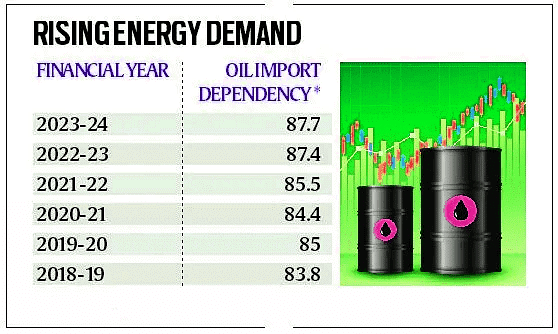
US Priority Watch List
Why in News?
Recently, the United States Trade Representative (USTR) has once again placed India on the 'Priority Watch List' (PWL) in its Special 301 Report, alongside countries like China, Russia, and Venezuela. This designation is due to ongoing concerns regarding the protection and enforcement of Intellectual Property (IP) rights in India. India has frequently appeared on this list in previous years, including 2020 and 2021.
What is the USTR's Special 301 Report?
- About: This report is mandated by Section 182 of the US Trade Act of 1974 and is published annually. It evaluates the adequacy and effectiveness of IP protection and enforcement practices in various countries that trade with the US.
- Designation Criteria: The USTR assesses factors such as the seriousness of IP concerns, the economic impact on US rights holders, and the progress made in addressing these issues when deciding which countries to place on the PWL or Watch List.
- Priority Watch List (PWL): Countries on this list face the most serious allegations of inadequate IP protection and enforcement. The USTR may initiate formal trade investigations or impose sanctions if significant improvements are not demonstrated.
- Watch List: This list includes countries with concerning IP practices, but the issues are not as severe as those on the PWL. The USTR monitors these countries and encourages them to enhance their IP frameworks.
US Government Initiatives:
- Advocacy Efforts: The USTR engages in bilateral negotiations, participates in the World Trade Organization (WTO), and collaborates with stakeholders to improve IP protection among trading partners.
- Technical Assistance: The US supports developing nations in strengthening their IP systems through training programs for legal and administrative personnel.
- Anti-Counterfeiting and Piracy Efforts: The USTR combats counterfeiting and piracy through coordinated actions, information sharing, and capacity building with allied nations and organizations.
What are the Concerns Raised Related to India in the Report?
- India's Placement: India has consistently been positioned on the 'Priority Watch List' in the Special 301 Report, highlighting substantial concerns about its IP protection, enforcement, and market accessibility for American IP stakeholders.
- Inadequate IP Enforcement: The USTR report points out several flaws in India's IP enforcement, including high levels of online piracy, a significant backlog in trademark opposition cases, and inadequate legal mechanisms for safeguarding trade secrets. This includes high customs duties on IP-intensive products and doubts about India's effective resolution mechanisms for pharmaceutical patent disputes.
- Copyright Compliance Issues: India is urged to fully implement the World Intellectual Property Organization (WIPO) Internet Treaties and to refrain from extending copyright licenses to interactive transmissions, ensuring that copyright holders’ rights are protected. Interactive transmissions involve user participation, such as streaming music or downloading videos.
- US-India Trade Policy Forum: While some progress has been observed under the US-India Trade Policy Forum regarding trademark infringement investigations and pre-grant opposition proceedings, several long-standing issues still need to be addressed.
- India’s Stand on Intellectual Property Rights: India maintains that its laws comply with the World Trade Organization’s Trade-Related Aspects of Intellectual Property Rights (TRIPS) Agreement and is not required to modify them according to other international regulations.
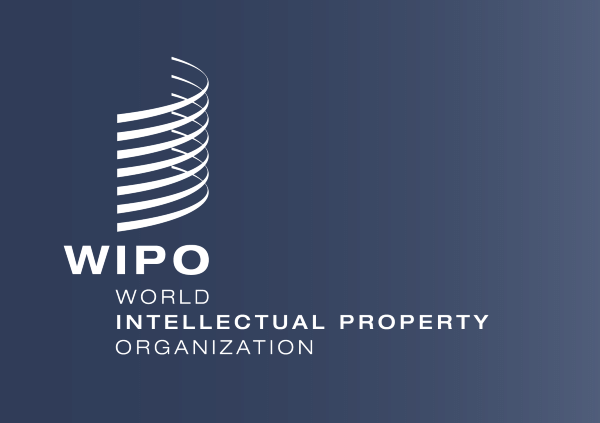
Way Forward
Joint IP Commission: Establish a permanent India-US IP Commission involving representatives from government, industry, and academia. This would be similar to the US-China IP Working Group, which has been effective in fostering dialogue and addressing specific issues. This commission could:
- Identify areas of mutual concern and prioritize joint action plans.
- Facilitate knowledge sharing on best practices in IP protection and enforcement.
- Develop harmonized IP policies to bridge legal discrepancies.
Focus on Capacity Building: The US can provide technical assistance to India's patent office and judiciary, which may include:
- Streamlining patent application processes to reduce backlogs.
- Enhancing training for judges and law enforcement on IP enforcement mechanisms.
Transparency and Stakeholder Engagement: Both nations should promote greater transparency in IP decision-making. Regular consultations with industry stakeholders can help identify practical challenges and solutions, drawing inspiration from the EU's transparent IP enforcement regime.
Dispute Resolution through Arbitration: A streamlined arbitration mechanism for resolving IP disputes between companies could involve:
- Independent panels of experts knowledgeable in both US and Indian IP law.
- Faster and more cost-effective resolution compared to traditional litigation.
Conclusion
By promoting collaboration, enhancing capacity building, and establishing efficient dispute resolution mechanisms, India and the US can move past the "Priority Watch List" narrative. This innovative approach, inspired by successful practices globally, could lead to a more cooperative and productive relationship, fostering innovation and economic growth for both nations.
UK Passes Bill to Deport Asylum Seekers to Rwanda
Why in news?
Recently, the United Kingdom government has enacted a contentious bill allowing the deportation of asylum seekers to Rwanda, aimed at reducing the influx of individuals crossing the English Channel.
What is the Rwanda Bill?
- The Safety of Rwanda (Asylum and Immigration) Bill was initiated by a former UK Prime Minister in 2022.
- Its primary objective is to facilitate the deportation of undocumented immigrants to Rwanda, recognized as a safe third country.
- A safe third country designation means that asylum seekers can be sent to a nation other than their own or where they seek refuge, provided it is considered safe.
- However, there is a lack of global consensus on this classification, leading to concerns about its practical application.
U.K.-Rwanda Deal on Refugees:
- In April 2022, the former UK Prime Minister introduced the Migration and Economic Development Partnership (MEDP), which aims to relocate asylum seekers not recognized by the UK to Rwanda.
- According to the Memorandum of Understanding (MoU) between the UK and Rwanda, the UK evaluates asylum requests and organizes transportation to Rwanda.
- Once in Rwanda, the country is responsible for providing shelter and protection, with sole authority to grant refugee status; those denied status are returned to their home countries.
Criticism:
- Wider Ramifications: The bill bypasses existing human rights laws and limits the appeal rights of individuals.
- It is part of a broader trend, with other European nations also considering similar arrangements with third countries for asylum processing.
- Human Rights Concerns: Critics contend that Rwanda does not offer sufficient protection for refugees and asylum seekers, citing its poor human rights history, including the 1994 genocide and ongoing political oppression.
- Reactions from the United Nations, the Council of Europe, and various NGOs highlight fears regarding the impact on human rights and the treatment of asylum seekers beyond UK borders.
- Lack of Safeguards: The bill is criticized for insufficient protections for the rights of asylum seekers, raising worries that deported individuals may face unfair asylum processes, risking arbitrary detention and removal.
Refugee Crisis in UK:
- Despite the risks, many refugees and asylum seekers have tragically died in 2023 while attempting to reach the UK.
- Their perilous journeys are often motivated by a combination of economic strife, political persecution, and worsening climate-related issues, such as environmental degradation and natural disasters.
- Their attempts to cross in overcrowded and unsafe boats exemplify their desperation for a better future.
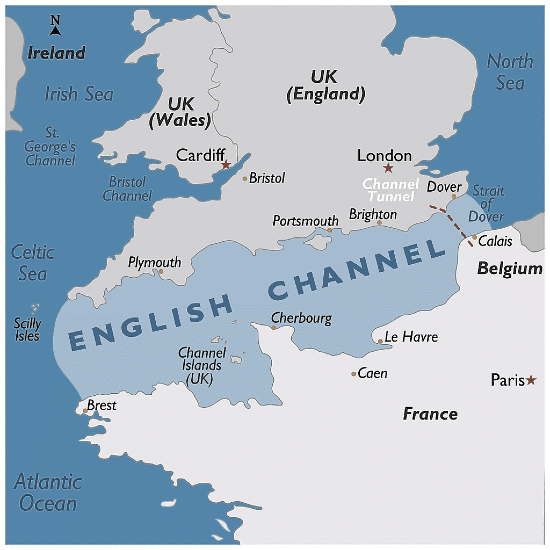
What are the Regulations Related to Refugees in India?
- India categorizes all foreigners—including illegal immigrants, refugees, and visa overstayers—under the Foreigners Act of 1946.
- Under Section 3 of this act, the central government can detect, detain, and deport illegal foreign nationals.
- According to the Passport (Entry into India) Act of 1920, authorities are authorized to forcibly remove illegal foreigners under Article 258(1) of the Constitution of India.
- The Registration of Foreigners Act of 1939 mandates that all foreign nationals (excluding Overseas Citizens of India) with long-term visas (over 180 days) must register with a Registration Officer within 14 days of arrival in India.
- The Citizenship Act of 1955 includes provisions for renunciation, termination, and deprivation of citizenship.
- Additionally, the Citizenship Amendment Act of 2019 (CAA) offers citizenship to persecuted Hindu, Christian, Jain, Parsi, Sikh, and Buddhist immigrants from Bangladesh, Pakistan, and Afghanistan.
- A Standard Operating Procedure (SoP) was established in 2011 and amended in 2019 for law enforcement agencies dealing with foreign nationals claiming refugee status.
Way Forward
- Comprehensive Immigration Policy Framework: There is a pressing need for a global immigration policy that encompasses various immigration aspects, including asylum, legal migration, and integration, balancing national security with humanitarian needs.
- Policy development should be grounded in empirical evidence and research rather than stereotypes or fear-driven narratives.
- Priority should be given to safeguarding vulnerable groups, including refugees and asylum seekers, ensuring they have equitable and efficient processes for seeking protection.
- Global Refugee Education Fund: UNESCO could establish a dedicated fund to enhance educational initiatives in refugee camps and host nations, empowering refugees through education and skill development.
- International Cooperation: Focus should shift towards collaborative efforts in managing migration flows, working with countries of origin and transit to tackle the root causes of migration.
- Integration and Inclusion: Emphasis should be placed on integrating and including migrants in host societies, ensuring access to education, healthcare, and job opportunities.
Practices for Inclusion:
- Language Support: Providing language courses aids migrants in integrating into the workforce and society.
- Recognition of Qualifications: Streamlining the process for acknowledging foreign qualifications enables migrants to utilize their skills effectively.
- Anti-discrimination Initiatives: Strong anti-discrimination laws and educational programs can create a welcoming and inclusive atmosphere.
- Refugee as "Resource": Acknowledging refugees as valuable contributors underscores the benefits of inclusion and collaboration in fostering vibrant communities.
Related Case Studies:
- Canada: Canada is recognized as a global leader in immigration, actively seeking skilled workers and refugees, which has driven economic growth and established Canada as a hub for innovation, especially in technology.
- Singapore: This country thrives on its diverse population, with migrants playing a crucial role in sectors like finance, engineering, and medicine, making its society dynamic and prosperous.
- Germany: Germany’s “guest worker” program in the 1960s recruited millions of workers to fill labor shortages, significantly contributing to the post-war economic recovery.
Long-Term Sustainable Solutions:
- There should be a shift towards long-term solutions that focus on conflict prevention and resolution, addressing the root causes of displacement, such as political instability and economic inequality.
- Investing in peacebuilding, development aid, and humanitarian diplomacy is essential to create lasting stability and security for communities affected by displacement.
Geopolitical Significance of Ports
Why in the news?
Recently, India signed a 10-year agreement with Iran for the development of the Shahid Beheshti Port Terminal at Chabahar Port.

More on the News
- The contract was finalized between India Ports Global Limited (IPGL) and the Ports and Maritime Organization (PMO) of Iran.
- IPGL is fully owned by Sagarmala Development Company Limited, which operates under the Ministry of Ports, Shipping and Waterways.
- In 2016, India, Iran, and Afghanistan entered into a trilateral agreement to develop Chabahar port.
- This port aims to reduce the distance from India's western coast to Afghanistan, Central Asia, and European nations, avoiding routes through Pakistan.
- Additionally, the Ministry of External Affairs (MEA) has approved the proposal to take over operations of the Sittwe port in Myanmar.
- Located on the Kaladan River, Sittwe port is part of the Kaladan Multimodal Transit Transport Project.
- These developments highlight the increasing significance of ports beyond economics, serving as critical tools of geopolitics.
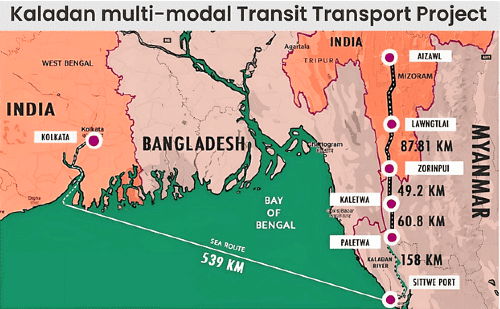
Govt. of India entered into a Framework Agreement with the Govt. of Myanmar in 2008 to create a multi-modal mode of transport to the North Eastern states through Myanmar.
- This agreement facilitates transportation from India's eastern ports (e.g., Vizag and Kolkata) to Myanmar and the northeastern region of India, bypassing Bangladesh.
- The initiative aims to lessen reliance on the Siliguri Corridor, often referred to as the "chicken's neck," which is situated between Bhutan and Bangladesh.
Strategic Significance of Ports
- Act as geopolitical assets: Ports enhance strategic reach, helping strengthen a country’s control over crucial sea and energy supply routes.
- Example: The Indian Navy’s base at Agalega Islands allows for marine patrols over the Mozambique Channel, monitoring commercial corridors in southern Africa.
- Strengthens Maritime Security: Access to Sittwe port in Myanmar enhances India’s maritime domain awareness in the Indian Ocean Region.
- Strengthening Bilateral and Multilateral Relationships: Access to Duqm Port in Oman facilitates India's engagement with Gulf nations.
- Port Diplomacy: Ports serve as vital nodes for trade and projection of naval power.
- Example: Access to Chabahar port in Iran enables India to form significant trade partnerships with Central Asia, countering China's economic influence.
- Economic Significance of Ports: Ports improve connectivity, promote trade, and integrate a country into the global value chain.
- They foster transactions in local currencies (e.g., Indian Rupee), aiding in internationalization.
- Port cities emerge as global hubs, positioning countries at the heart of international trade and finance.
- Alternative Routes for Economic and Energy Security: Investment in Gwadar port (Pakistan) allows China to bypass the Strait of Malacca for shorter routes to the Middle East, Africa, and Europe.
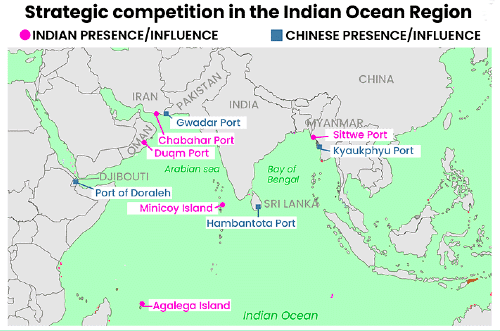
Challenges in Strategic Use of Ports
- Rivalry Among Nations: Ports are central to the competition between China and India for regional influence, exemplified by China’s "string of pearls" and India’s "necklace of diamonds" strategies.
- String of Pearls: This concept suggests China aims to encircle India with Chinese-influenced ports throughout the Indian Ocean.
- Loss of Sovereignty: Control by rival nations over strategic ports can undermine a nation's long-term interests.
- Example: China's debt diplomacy related to Hambantota port in Sri Lanka has contributed significantly to Sri Lanka's economic crisis.
- Security and Safety Concerns: Issues such as piracy and foreign ownership of ports pose significant risks.
- Heightened Vulnerability: Transportation channels, especially chokepoints, may be disrupted during geopolitical tensions.
- Challenges Related to India: Smaller neighboring countries (Sri Lanka, Bangladesh, Maldives) often feel trapped in the geopolitical rivalry between China and India.
- India faces limited financial resources to expand its geopolitical influence through port developments.
Way Forward
- At Global Level: There is a need to monitor risks associated with irresponsible lending and the misuse of commercial agreements at host country ports to support military activities.
- Building global security partnerships is crucial to protect ports from opaque economic activities that threaten sovereignty and global interests.
- India Specific Measures: India should explore multilateral partnerships with like-minded nations (e.g., QUAD countries) to safeguard its maritime security interests and limit China’s influence.
- Establishing a stronger presence in the Western Indian Ocean Region is vital, as China is at a geographical disadvantage due to its remote location.
Conclusion
Ports not only connect land and sea but also serve dual roles as economic gateways and strategic projection points. Effective management of ports is essential in the context of the current geopolitical landscape.
Disaster Diplomacy
Why in the news?
Recently, the 6th edition of the International Conference on Disaster Resilient Infrastructure (ICDRI) was held in India, highlighting the country's growing role in global crisis response efforts.
About Disaster diplomacy
- Disaster diplomacy is an emerging field that examines how disasters influence international relations.
- It involves a nation’s initiatives to offer support and aid to countries facing natural or man-made disasters.
- This approach includes deploying personnel, resources, and assistance to aid those affected.
- The "Oslo Guidelines," established in 1994 and updated in 2006, outline the principles for humanitarian assistance by UN agencies.
Significance of India’s disaster diplomacy
- Soft Power Projection: By providing aid during emergencies, India seeks to build goodwill and strengthen international relations.
- Increased Geopolitical Reach: India's response to crises, from Japan to Turkey, reflects its emerging status as a major power.
- Breakthroughs in Bilateral Ties: Operations like Operation Maitri during the 2015 Nepal earthquake significantly improved India-Nepal relations.
- Strategic Importance of Humanitarian Assistance and Disaster Relief (HADR): India views HADR as crucial for its foreign policy, countering influences from nations like China.
- India's approach emphasizes non-intrusiveness, focusing solely on assisting affected nations while respecting their sovereignty.
Factors contributing to India's global crisis response
- India strives to enhance its status as a regional power and seeks a permanent seat on the UN Security Council, leading to more development assistance during crises.
- The commitment to the Global South and the Neighbourhood First Policy reinforces regional partnerships and capacity building.
- India leverages its domestic disaster management capabilities developed from previous emergencies.
- Robust economic growth provides India with the resources needed for effective disaster diplomacy.
India's Approach towards disaster relief
- First Responder to Natural Disasters: India has initiated Operation Dost to aid in the aftermath of earthquakes in Turkey, showcasing a consensus approach to conflict management.
- Capacity Building: India aids countries like Nepal, Maldives, and Bangladesh in developing Early Warning Systems under the UN's 'Early Warnings for All (EW4All)' initiative to minimize disaster impact.
- Helping People in Conflict Zones: Through Mission SAGAR, India has provided essential supplies and medical assistance to countries like Mauritius and Comoros.
- Post-conflict Relief and Rehabilitation: India focuses on rebuilding efforts in Nepal, Sri Lanka, and Afghanistan to help them recover from prolonged conflicts.
- UN Peacekeeping: India has played a significant role in peacekeeping missions to aid stabilization and reconstruction efforts.
- Managing Health Disasters: During the COVID-19 pandemic, India launched the COVID-19 Vaccine Maitri program, assisting over 100 countries.
Key challenges faced by India in its Disaster diplomacy
- Lack of Technological Capacities: India's response to the 2011 Fukushima disaster was delayed due to inadequate resources from the National Disaster Response Force (NDRF).
- Limited Impact: Assistance to Nepal has not yielded long-term benefits, with bilateral relations strained over territorial disputes since 2021.
- Geopolitical Tensions: Existing tensions with neighboring countries can impede collaboration during disaster response efforts.
- Potential Rejection Due to Historical Hostilities: For instance, Pakistan declined India's aid during the 2022 floods.
Way Forward
- Disaster diplomacy is becoming increasingly vital in India's foreign policy strategy, particularly in response to climate change-related disasters.
- India must enhance its HADR capabilities through investments in necessary equipment to improve response times.
- The NDRF should integrate technology into its operations and develop better standard operating procedures (SOPs) for quicker responses.
- Improved budgetary allocations are necessary for emergency preparedness and logistical capabilities.
- India should better project its humanitarian achievements as it aims to establish itself as a global power.
- Emerging forums like the Quad (Australia, Japan, India, and the USA) should be leveraged for humanitarian and disaster relief initiatives, enhancing India's reputation as a capable power.
Instability in West Asia
Why in the news?
Recent tensions in West Asia have escalated significantly, highlighted by Israel's strike on the Iranian consulate in Syria, prompting a retaliatory response from Iran. This situation underscores the growing instability in the region.
More on the news
- The Iranian response was intercepted by Israel, which deployed a multi-layered air defense system, including the Iron Dome, Arrow, and David’s Sling.
- Allegations suggest that Exoatmospheric Missiles (EMs) were utilized in intercepting the attack.
- Reports have emerged regarding attacks by Houthi forces in the Red Sea.
- International institutions, including the United Nations, IMF, and World Bank, have expressed concerns over the potential threats these conflicts pose to economies and political stability in the region, including India.
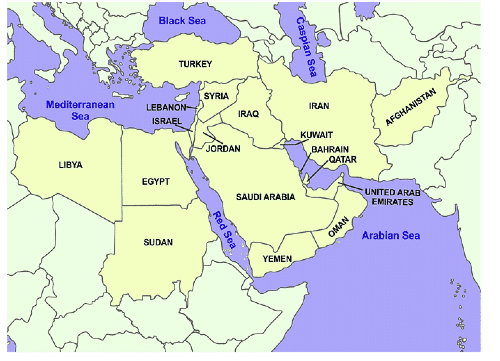
Other Major conflicts in the West Asia
- Terrorist factions: Hezbollah in Lebanon, ISIS in Syria.
- Civil Wars and Insurgency:
(a) Sudan: Conflict between military factions.
(b) Yemen: Ongoing Houthi conflict.
(c) Egypt: Insurgency in the Sinai Peninsula.
About Exoatmospheric missiles (EMs)
- EMs, also known as anti-ballistic missiles (ABMs), are engineered to intercept and destroy incoming ballistic missiles during their mid-course or terminal phase.
- They utilize advanced sensors, including infrared and radar systems, to detect and track threats.
- Guidance systems are employed to accurately maneuver and intercept targets moving at high velocities in space.
Different types of exoatmospheric missiles
- Kinetic kill vehicles: These destroy targets through direct physical impact.
- Directed energy weapons: These utilize lasers or other energy beams to neutralize or destroy incoming threats.
What are the impacts of instability in the West Asia?
On India
- India's diplomatic and strategic balancing act may be challenged due to its interactions with nations that have conflicting interests (e.g., the emergence of the Iran-Russia-China axis).
- Maritime security threats, such as drone strikes and hijackings (e.g., Houthi attacks in the Red Sea), may impact freedom of navigation in India's maritime areas.
- The safety and security of the Indian diaspora in the Middle East could become increasingly precarious.
- Energy security is at risk, as India relies heavily on imported crude oil (approximately 85%).
- Delays in infrastructure projects like the India-Middle East-Europe Economic Corridor (IMEC) may occur.
- Disruption in global maritime trade and supply chains could lead to rising fuel prices, negatively affecting inflation, pharmaceutical exports, trade balance, forex reserves, stock market performance, and the overall economy.
- Increased shipping costs and insurance premiums may arise.
- Diplomatic achievements (e.g., Abraham Accords, Israel-Saudi relations) could be jeopardized.
- Maritime security challenges may intensify across the Indo-Pacific region if attacks occur on vessels of the USA or UK.
- Competition among nations for arms and nuclear capabilities may lead to broader global instability.
At Global Level
- Higher oil prices could result in increased food prices, exacerbating food insecurity in various countries.
- Economies directly impacted may face downgrades, and global investment sentiment could decline.
- An international humanitarian crisis may emerge due to loss of life, forced displacements, and allegations of war crimes (e.g., the Rafah Offensive by Israel).
- Questions are being raised regarding the effectiveness and relevance of international institutions, such as the United Nations Security Council.
Way Forward
- Enhance diplomatic engagements and encourage negotiations among all parties to prevent further violence and seek peaceful resolutions.
- Establish a normative framework and process through arms control and security negotiations, including the declaration of a regional “Weapons of Mass Destruction Free Zone” aimed at demilitarization.
- Address the Israeli-Palestinian conflict based on the Two-Nation Theory to promote long-term security, peace, and stability.
- Support fiscal and external sustainability for countries by strengthening policy buffers.
- Provide India with an opportunity to position itself as a net security provider and mediator for South-South cooperation.
- Conduct maritime security operations by the Indian Navy (Operation Sankalp) and the USA (Operation Prosperity Guardian) in regions like the Gulf of Aden, Arabian Sea, and off the East Coast of Somalia to counter various non-traditional threats.
Conclusion
- India should remain aware of its diverse interests in the region, including energy security, maritime safety, and the well-being of its diaspora.
- India can leverage its civilizational ties to maintain balanced relationships with various nations and engage strategically with neutral parties to protect its geopolitical and geoeconomic interests.
|
44 videos|5271 docs|1113 tests
|
FAQs on International Relations - 5 - Current Affairs & Hindu Analysis: Daily, Weekly & Monthly - UPSC
| 1. What is the historical background of relations between Iran and Israel? |  |
| 2. What are the key events that led to Iran's attack on Israel? |  |
| 3. How may the Iran-Israel war impact the world? |  |
| 4. What could be the possible solutions to de-escalate the Iran-Israel conflict? |  |
| 5. What is the Rwanda Bill and how does it relate to the UK's deportation of asylum seekers? |  |
















